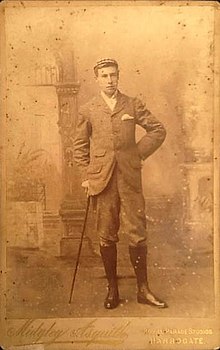Ardlamont murder
The Ardlamont Murder (also known as the Ardlamont Mystery and the Monson Case[1]), which took place in Argyll, Scotland, on 10 August 1893, gave rise to two high-profile court cases: a murder trial in Edinburgh (HM Advocate v Monson), and a defamation trial in London (Monson v Tussauds Ltd) the following year.
Alfred John Monson received the Scottish verdict of "not proven" in his High Court of Justiciary trial for the murder of Cecil Hambrough. Then, in 1894, he sued Madame Tussauds for libel and was awarded one farthing (the lowest possible amount at the time) in damages. The case established the principle of "libel by innuendo" in English law, and Monson v Tussauds Ltd[2] has been used to draw up defamation laws in many countries since.
A notorious case at the time, the trial received renewed attention when it was noted that Joseph Bell, revealed as the inspiration for the popular fictional character Sherlock Holmes, had been called as an expert witness at the murder trial.
Background
Alfred John Monson was born in 1860 the son of Reverend Thomas John Monson and his wife the Hon. Caroline Isabella Monckton, daughter of the 5th Viscount Galway. He married Agnes Maude Day in 1881.[3]
Windsor Dudley Cecil Hambrough, born 1873, was a member of the Hambrough family of Pipewell Hall, Northamptonshire and Steephill, Isle of Wight.

Monson began working as a gentleman's tutor for the Hambrough family in 1891. In 1893 he took the lease on the Ardlamont estate in Argyll for the shooting season. On 10 August he took Windsor Dudley Cecil Hambrough, his 20-year-old[4] pupil, for a day's hunting in an area of woodland. A third man joined them, Edward Scott, a friend of Monson who had arrived at the estate a few days earlier.
Estate workers heard a shot, then saw Monson and Scott running to Ardlamont House carrying the guns. They were cleaning the weapons when the estate butler asked what had become of Mr Hambrough. Monson replied that he had shot himself in the head by accident while climbing a fence.
Investigation and trial
When the incident was reported, a member of the Inveraray procurator fiscal's office was sent to the estate. He returned, saying it had been a tragic accident. However, two weeks later, Monson appeared at the fiscal's office to report that Hambrough had taken out two life insurance policies worth £20,000 only six days before he died, and that they were made out in the name of Monson’s wife. After thorough searches of the estate and interviews with staff, Monson was charged with murder. Scott, now on the run, was named as his accomplice.
Among the witnesses for the prosecution was Joseph Bell, the Edinburgh surgeon and forensic detective. He told the jury that, in his opinion, Monson had murdered Cecil Hambrough. However, sufficient doubt had been sowed in the minds of the jury by Monson's advocate John Comrie Thomson, and Monson was set free with the verdict of "not proven."[5]
Hambrough was buried in the churchyard at St Catherine's Church, Ventnor on the Isle of Wight, close to the family home.[6][7]
Libel by innuendo
In 1894 Madame Tussauds in London erected a waxwork of Monson at the entrance to its Chamber of Horrors, bearing a gun. Monson took exception, sued the company and was awarded one farthing in damages.[8] The case, Monson v Tussauds, established the principle of "libel by innuendo",[9] which has been used to draw up defamation laws in many countries since. To prove libel, there must be publication in permanent form, but this need not be in words.[10]
Television Dramatisation
BBC Scotland Television produced an adaptation based on the case and broadcast in 1984. Murder Not Proven: Open Season was scripted by the future novelist Peter May.[11]
References
- Keedy, Edwin R (1913). "Criminal Procedure in Scotland". Journal of the American Institute of Criminal Law and Criminology. Northwestern University.
- [1894] 1 Q.B. 671
- "Person Page". thepeerage.com. Retrieved 10 September 2019.
- Edited by John W. More, B.A. (Oxon.), Advocate. Trial of A.J. Monson, Publisher: William Hodge & Company, Glasgow and Edinburgh, 1908
- Lundy, Iain (12 December 2005). "The Ardlamont mystery: Tragic mistake or calculated evil?". The Scotsman. Retrieved 3 February 2011.
- "Findagrave". Archived from the original on 10 September 2019. Retrieved 10 September 2019.
- Archibald, Malcolm, author. Whisky wars : riots and murder in the 19th century Highlands and Islands. ISBN 9781785302398. OCLC 1099339931.CS1 maint: multiple names: authors list (link)
- Pilbeam (2006). Madame Tussaud: And the History of Waxworks. Continuum International Publishing Group. p. 211. ISBN 1-85285-511-8.
- Monson v Tussauds [1894] 1 QB 671
- Deakin, Johnston and Markesinis (2008). Markesinis & Deakin's Tort Law. Oxford University Press. p. 757. ISBN 978-0-19-928246-3.
- "Murder Not Proven?". 17 May 1984. p. 59 – via BBC Genome.